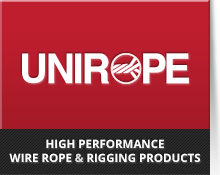Inspection of Sheaves and DrumsProper maintenance of the equipment on which the ropes operate has an important bearing on rope life. Worn grooves, poor alignment of sheaves and worn parts resulting in shock loads and excessive vibration will have a deteriorating effect. Sheaves should be checked periodically for wear in the grooves which may cause pinching, abrasion, and bird-caging of the rope. If the groove shows signs of rope imprints the sheave must be replaced or re-machined and re-hardened. The same should be done on drums showing similar effect. Poor alignment of sheaves will result in rope wear and wear on the sheave flange. This should be corrected immediately. Excessive wear in the sheave bearings can cause rope fatigue from vibration. Large fleet angles will cause severe abrasion of the rope as it winds onto the drum. Furthermore, the rope will roll into the sheave groove introducing torque and twist which may cause high stranding and bird-cages. |
Dimension of the Groove RadiusThe very first item to be checked when examining sheaves and drums, is the condition of the grooves. To check size, contour and amount of wear, a groove gauge is used. Two types of groove gauges are in general use and it is important to note which of these is being used. The two differ in their percentage over the Nominal Rope Diameter. For new or remachined grooves, and for inspection of fitness for new ropes, the groove gauge should be 1% over the maximum allowable Plus Tolerance of the new rope; alternately, the sheave groove must measure 1% over the Actual Rope Diameter intended to be installed. Many groove gauges on the market are so called ‘No-Go’ gauges and are made with Nominal plus 1/2 of permissible rope Plus Tolerance. If you use these gauges be sure that the existing rope is SMALLER than this gauge. A rope operating in an even slightly undersized groove, deteriorates faster and may develop bird-cages. |
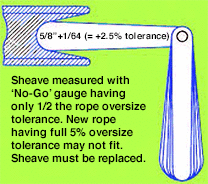 |
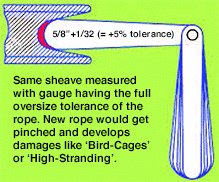 |
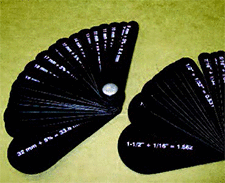 |
| Correctly +5% sized plastic and stainless steel sheave gauges available from Unirope. |
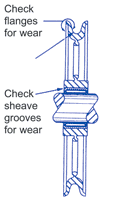 |
 |
 |
 |
 |
 |
| Check bearings for wobble, lubrication & ease of rotation. | Properly matched rope & sheave groove. | Sheave groove too small. | Sheave groove is undercut. | New rope will get damaged beyond repair. | A sheave corrugated by the rope’s ‘print’. This sheave will damage the rope. |



